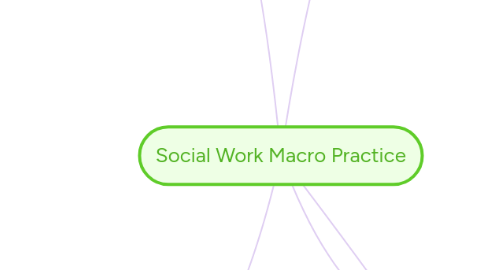
1. Assessing Human Service Organizations
1.1. Dill (1958) Key Components of an Organizational Task Environment
1.1.1. 1. Consumers – clients and customers
1.1.2. 2. Suppliers – work area, materials, labor, capital, and equipment
1.1.3. 3. Competitors – for resources and markets
1.1.4. 4. Regulators – government and accrediting organizations
1.2. Resource dependence – All organizations rely on elements within their environment to get the resources that they need for survival
1.2.1. Major implication: funding – organizations that are able to obtain a more predictable and diverse funding base are able to have a better diversity of services and better opportunities for expansion. Example: secular organizations vs. faith-based organizations.
1.3. Contingency theory – internal processes and structures within an organization are shaped by external relationships and forces.
1.4. Eligibility criteria – factors that a client meets that determine if they fit within the organization and it’s services.
1.4.1. Ethical considerations – systematic oppression and clients’ financial relationship with the organization
1.5. Miles (1975) Managerial Theories or Models
1.5.1. 1. Traditional model – Very closely supervised, under the assumption that people do not like to work and are not self-motivated.
1.5.2. 2. Human relations model – Management is open to feedback, subordinates are self-directed and made to feel useful and important.
1.5.3. 3. Human resources model – Management expected to create an environment where everyone can contribute, under the assumption that people want to contribute and have something useful to contribute to the team.
1.6. Types of Budgeting
1.6.1. Line-item budgeting – Identifying expenditures and estimating the cost to cover expenses in each category for one year.
1.6.2. Functional budgeting – Costs are calculated based on breakdown of total program costs. Example: cost per completion of program or cost per output. Gives an advantage for determining outcomes of programs.
2. Selecting Appropriate Strategies and Tactics
2.1. Lewin's (1947) Force-Field Analysis Model
2.1.1. Unfreezing, moving/changing, refreezing
2.1.2. Application – to determine the chances of success
2.2. Three Types of Strategies (Considerations – These strategies are on a continuum, it is almost always beneficial to begin with collaboration, and then to adjust.)
2.2.1. Collaboration
2.2.1.1. Tactics: Implementation and capacity building
2.2.1.2. Benefits: Leads to coalition building
2.2.1.3. Challenges: recognizing when organizational cultures clash
2.2.2. Campaign
2.2.2.1. Tactics: Education, persuasion, cooptation and lobbying
2.2.2.2. Benefits: Opponents may be willing to listen
2.2.2.3. Challenges: Requires a good amount of skill
2.2.3. Contest
2.2.3.1. Covert tactics – Used without transparency, not apparent to the public.
2.2.3.1.1. May be ethical for social workers in some situations, would need to follow the same ethical review as a social work in private practice.
3. Netting, F., Kettner, P., McMurtry, S., & Thomas, M. (2012). Social work macro practice (5th ed.). Boston, MA: Pearson Education.
4. Building Support for the Proposed Change
4.1. Framework for Developing an Intervention Strategy
4.1.1. 1. Develop the intervention hypothesis
4.1.2. 2. Define participants
4.1.3. 3. Examine system capacity for change
4.1.4. 4. Select a change approach
4.2. Why is important that participants be identified in a systematic manner? To be sure to fully represent a full range of perspectives.
4.3. Three Questions to Ask When Defining the Target System
4.3.1. 1. What change, or series of changes, needs to take place for the primary beneficiaries to achieve the desired benefits?
4.3.2. 2. What individuals, or groups, need to agree to the change (or changes)?
4.3.3. 3. What needs to change in order for the intervention to be successful (according to the intervention hypothesis)?
4.4. Five Approaches to Change
4.4.1. 1. Policy – Broad changes
4.4.2. 2. Program – To establish a new program or alter existing programs
4.4.3. 3. Project – To demonstrate a new or untested intervention
4.4.4. 4. Personnel – Problem-solving between community residents or members.
4.4.5. 5. Practice – Changes in the way an organization or individual goes about doing business
5. Planning, Implementation, Monitoring, and Evaluating the Intervention
5.1. Goal – states target population, boundary, and expected result or outcome
5.2. Objective – An elaboration of goals
5.2.1. 1. Establish a time frame for the objective
5.2.2. 2. Define the target population
5.2.3. 3. Specify a result or outcome
5.2.4. 4. Define a criterion for measuring success
5.3. Activities – Lists of tasks to be completed in order to achieve objectives
5.3.1. Gantt chart – A tool to monitor the progress of activities. It is made up of columns and rows, with each row identifying the activity, and the columns identifying the activity number, persons responsible, and the beginning and end dates
5.4. Monitoring – Tracking progress in order to ensure efficiency.
5.5. Evaluating – Determining the value by studying and appraising.
5.6. Rapp and Poertner (2007) Suggestions for Report Writing
5.6.1. 1. Avoid too much information
5.6.2. 2. Establish a standard
5.6.3. 3. Pay attention to aesthetics
5.6.4. 4. Explain tables, graphs, and charts in simple English
5.6.5. 5. Make aggregation meaningful
